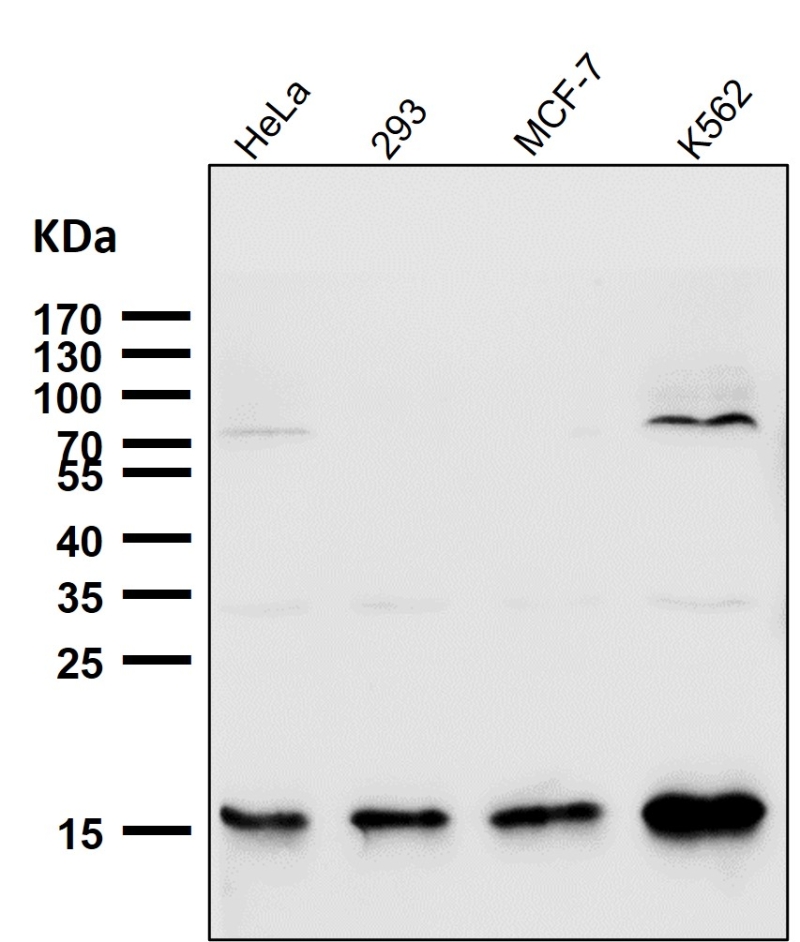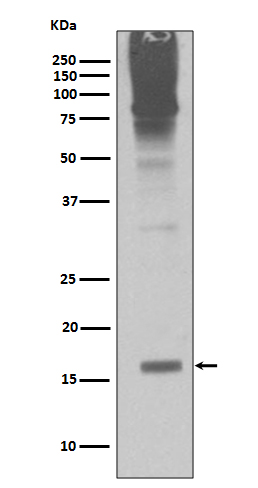

| WB | 咨询技术 | Human,Mouse,Rat |
| IF | 咨询技术 | Human,Mouse,Rat |
| IHC | IHC:1/100-1/200;IHF:1/50-1/200 | Human,Mouse,Rat |
| ICC | 1/50-1/200 | Human,Mouse,Rat |
| FCM | 咨询技术 | Human,Mouse,Rat |
| Elisa | 咨询技术 | Human,Mouse,Rat |
| Aliases | SUMO2; HSMT3; SMT3 homolog 2; SMT3A; Sentrin 2; Smt3B; SMT3H2; SUMO-2; SUMO-3; Sentrin-2; Ubiquitin-like protein SMT3A; Ubiquitin-like protein SMT3B;;Sumo 2/3 |
| WB Predicted band size | Calculated MW: 11,12 kDa ; Observed MW: 16 kDa |
| Host/Isotype | Rabbit IgG |
| Antibody Type | Primary antibody |
| Storage | Store at 4°C short term. Aliquot and store at -20°C long term. Avoid freeze/thaw cycles. |
| Species Reactivity | Human,Mouse,Rat |
| Immunogen | A synthesized peptide derived from human Sumo 2 |
| Formulation | Purified antibody in PBS with 0.05% sodium azide,0.05% BSA and 50% glycerol. |
+ +
以下是关于SUMO2/3抗体的3篇参考文献,涵盖抗体的开发、验证及生物学应用:
---
1. **"Characterization of SUMO-2/3-specific antibodies for biochemical analyses"**
*作者:Tatham, M.H. et al. (2008)*
**摘要**:本文报道了多种SUMO-2/3特异性抗体的开发与验证,通过免疫印迹和免疫荧光实验证明其不与SUMO-1交叉反应。研究发现SUMO-2/3修饰在细胞应激(如热休克)后显著增加,提示其动态调控机制。
2. **"SUMOylation promotes HIV-1 latency by reinforcing pre-existing condensation of the viral genome"**
*作者:Ouyang, J. et al. (2022)*
**摘要**:研究利用SUMO2/3抗体(如Anti-SUMO2/3. 8A2)结合ChIP-seq技术,揭示SUMO化修饰通过相分离机制维持HIV-1病毒基因组沉默。抗体特异性验证显示其对SUMO2/3的强识别能力。
3. **"Development of a monoclonal antibody specific for SUMO-2/3"**
*作者:Matic, I. et al. (2010)*
**摘要**:本研究开发了一种高特异性单克隆抗体(8A2),可区分SUMO-1与SUMO2/3.通过质谱和功能实验验证其适用于免疫沉淀和内源性SUMO化蛋白检测,为研究SUMO2/3在细胞周期调控中的作用提供工具。
---
**备注**:SUMO2/3抗体(如8A2)常用于研究蛋白质SUMO化修饰的动力学及生物学功能,尤其在应激响应、病毒潜伏和疾病模型中广泛应用。建议结合具体实验需求选择经充分验证的抗体。
SUMO (Small Ubiquitin-like Modifier) proteins are a family of ubiquitin-like molecules that post-translationally modify target proteins to regulate their activity, localization, or interactions. The SUMO family includes SUMO1. SUMO2. and SUMO3. with SUMO2 and SUMO3 sharing ~97% sequence identity and often referred to collectively due to their functional redundancy. SUMOylation involves covalent conjugation of SUMO to lysine residues on substrate proteins via an enzymatic cascade, influencing diverse cellular processes like nuclear transport, DNA repair, transcriptional regulation, and stress responses.
Antibodies targeting SUMO2/3 are critical tools for studying SUMOylation dynamics. These antibodies detect either free SUMO2/3 or SUMO-conjugated proteins, enabling researchers to investigate SUMOylation in contexts such as cellular stress, cell cycle progression, or disease states. Unlike SUMO1. SUMO2/3 can form poly-SUMO chains, which are implicated in stress responses and protein degradation pathways. Specificity is a key consideration, as some antibodies distinguish SUMO2 from SUMO3. while others recognize both isoforms.
SUMO2/3 antibodies are widely used in techniques like Western blotting, immunofluorescence, and immunoprecipitation to map SUMOylation sites, identify substrates, or explore crosstalk with other post-translational modifications. Dysregulation of SUMO2/3 modification is linked to cancer, neurodegeneration, and viral infection, making these antibodies valuable for both basic research and therapeutic target discovery. Their utility also extends to validating SUMO protease activity or assessing the effects of SUMOylation inhibitors in experimental models.
×